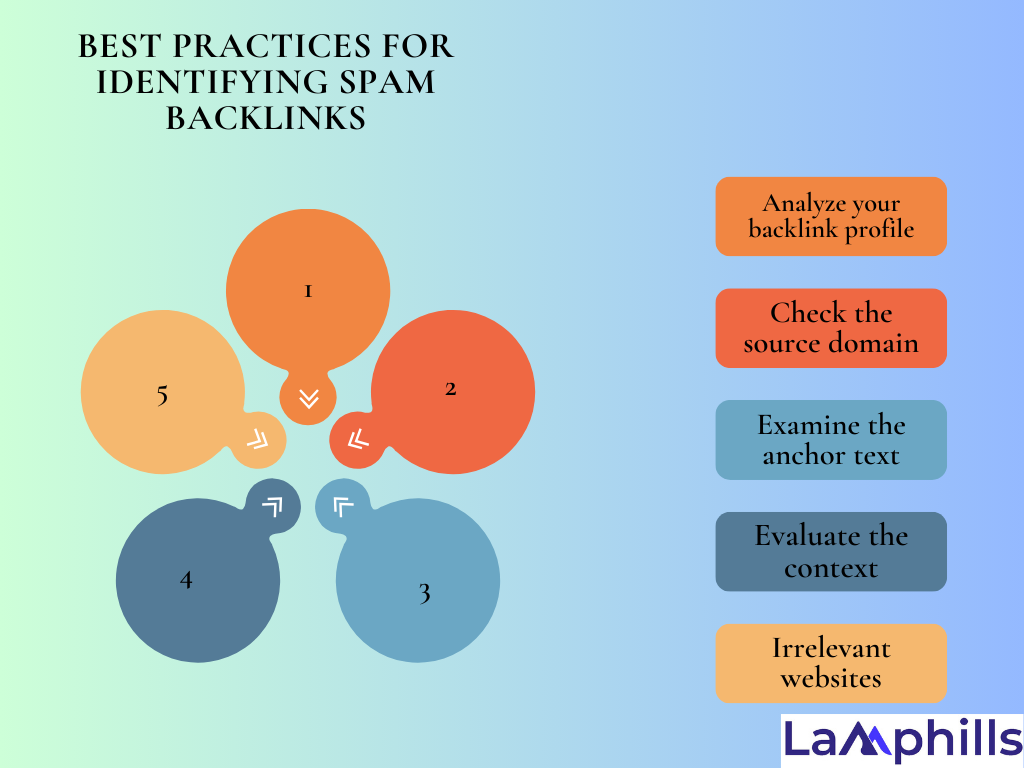A few months ago, I was in the middle of my usual morning routine—coffee in hand, laptop open, ready to take on another day of SEO problems. However, that day was different. I signed in to check the traffic on one of my client’s websites, and my heart sank when I noticed a sharp dip. It was like a rollercoaster, and we were going downhill at full speed.
I needed to find out what was going on, and quickly. After ruling out all the obvious suspects—no broken links, no major algorithm upgrades, no server issues—I discovered the culprit: spam backlinks. If you’re not familiar with the term, spam backlinks are those dubious links that originate from low-quality, irrelevant websites. They’re the dark side of SEO, and they may harm your rankings.
As a result, this article will walk you through the dark depths of spam backlinks. I will explain what they are how they can hurt your website, and most importantly, how to identify and get rid of them. By the end, you’ll be equipped to protect your website’s reputation and climb those search engine rankings like a champion!
Key Points
- Spam backlinks are low-quality links from irrelevant websites that can hurt your website’s credibility and search engine ranking.
- Signs of spam backlinks include irrelevant websites linking to you, poor grammar on linking websites, unnatural anchor text, and sudden surges in backlinks.
- Tools like Google Search Console, Ahrefs, SEMrush, and Backlink Monitor can help you identify spam backlinks.
- You can deal with spam backlinks by contacting webmasters for removal, disavowing them using Google’s Disavow Tool (with caution!), or focusing on building high-quality backlinks.
- Building a strong backlink profile involves creating high-quality content, guest blogging, industry outreach, and prioritizing quality over quantity.
What are Spam Backlinks?
Spam backlinks are links pointing to a website from low-quality, irrelevant, or spammy sources. These links are frequently established using automated procedures or malevolent intent to manipulate search engine results or exploit a website’s authority. While Google and other search engines have improved their ability to recognize and devalue spam backlinks, they can still have a major negative impact on a site’s SEO.
The funny part is that you don’t have to do anything to create these linkages (though many people do); they develop spontaneously over time.
Spammers often target websites for a variety of reasons. When Google identifies these types of connections, it will either eliminate their SEO value (in this example, negative SEO), which is the best-case scenario for a website owner, or punish you for them.
generally, a Google penalty comes when they assume you built those spam backlinks yourself. Because backlinks are such a crucial piece of the page rank puzzle, SEOs, and link builders will often build links using whatever means necessary. Google only wants to see high authority backlinks, however, and if it notices too many unnatural, spammy-looking backlinks, it could hit you with a manual action penalty. These can be hard to recover from and, depending on the severity can have a material impact on your revenue.
Understanding Spam Backlinks
Finding spam backlinks isn’t always easy. This is because they tend to hide in plain sight, often buried deep within backlink profiles.
I’ll tell you what, creating a website may sometimes feel like creating a castle. You put in time, resources, and sweat (well, maybe not sweat, but brainpower!). Then create something truly remarkable, user-friendly interface, generate fantastic content, and search engines optimize everything.
Then, one day you monitor the traffic to your website and, wow, it has dropped like an idle horse tumbling over the battlefields. You try to work out what went wrong. Has Google made any more algorithmic changes? Have your rivals unveiled a surprise weapon?
There’s a chance that spam backlinks, something a lot more covert that you might not even detect, are the culprit. Now, before the idea of SEO terminology makes your eyes glaze over, allow me to explain.
Spam backlinks are like silent enemies, steadily undermining your website’s trustworthiness and search engine ranking. Here’s the deal: a solid online reputation is essential. Search engines like Google regard websites with a strong backlink profile, which consists of links from other websites going back to yours, as more trustworthy and authoritative. These backlinks work as votes of confidence, increasing your website’s prominence in search results. However, not all backlinks are equal. Spam backlinks are from irrelevant or untrustworthy sources and might harm your website in the long run.
Types of Spam Backlinks
The linking website’s quality is what distinguishes bad backlinks from excellent ones. They can be divided into categories according to the type of website from which they originate. Here are the various kinds of spam backlinks you may come across:
#1. Links Coming from Link Networks

A collection of linked websites is called a link network. Usually, their only goal when they are formed is to give you a lot of backlinks. They pose as blogs or forums, however, there are hardly any hyperlinks referring to any of their discussions or posts. Furthermore, there’s a good chance that they contain a ton of cross-linking and duplicate material.
Search engines view backlinks to your website coming from these kinds of link networks as dubious activity. Furthermore, the connections that are connected to link networks are frequently devalued and deindexed by search engine spiders. The usage of these link schemes is discouraged by Google Search Essentials, formerly known as Google Webmaster Guidelines.
#2. Sitewide Links
These links can be found on every page of a website. They usually show up in a website’s sidebar, footer, and header sections. For example, WordPress-developed websites have a footer section link to WordPress.org.
Before Penguin, a lot of website owners employed this strategy to acquire a lot of backlinks rapidly. It can, however, lead to your website being penalized as it is now seen as unnatural. One backlink from a domain with high authority is far more beneficial than several from one with low authority.
#3. Links from Blog Comments
If you’ve ever operated a blog, you may have noticed a flood of spam in the comments section. These comments, which frequently include links to other websites, are set to nofollow to prevent Google from indexing them. Spam comments that connect to your website hurt your inbound link profile.
#4: Directory Links
Web directory submissions are a great technique to get high-quality backlinks organically. However, this only applies to directories with high authority and relevance to your niche. If your website has too many backlinks from random and low-quality directories, it is likely to get penalized.
#5. Links with Over-Optimized Anchor Texts
The anchor text for your backlinks is crucial to your overall SEO strategy. But, if your website receives an excessive number of backlinks with exact-match keywords, Google’s spam filter will kick in.
Let’s pretend you own a watch store. If too many sites link back to your website using “designer watches” as the anchor text, Google will consider this unnatural. It could be interpreted as an indication of manipulation, and your website will be penalized.
Tools For Removing Spam Backlinks
There are also some handy tools available to help you unearth the backlink mystery and identify those sneaky spam visitors. Here are a few popular options:
#1. Google Search Console
Google’s free tool is a goldmine for website owners. It displays a list of websites that link back to yours, including anchor text and other useful information. While Google Search Console does not directly state whether a backlink is spam, you can use the red flags stated previously to make an informed decision.
#2. Ahrefs and SEMrush
These are effective SEO tools that provide a more in-depth backlink analysis. They provide precise information about the quality and authority of linked websites, allowing you to identify potential spam backlinks. Although these are paid programs, many do provide free trials to get you started.
#3. Backlink Monitor
This free application allows you to track your backlinks over time and be notified of any new ones. This can help you remain on top of your backlink profile and identify spam early on.
#4. Rank tracker
Rank tracker is another widely used tool for backlink research. It provides precise information on the quality and relevancy of your backlinks, allowing you to avoid spam backlinks entirely.
#5. Webmaster Forums and Communities
Participate in webmaster forums and online communities to get tips and learn from the experiences of others. These systems can provide useful insights and advice on how to properly manage spam backlinks.
Best Practices for Identifying Spam Backlinks

Detecting spam backlinks isn’t rocket science, but it does require a keen eye and a bit of detective work. Keep an eye out for red flags like
#1. Analyze Your Backlink Profile
Use a reliable backlink analysis tool to evaluate the quality of your backlinks. Look for suspicious patterns, such as a sudden increase in backlinks or many links from irrelevant websites.
#2. Check the Source Domain
Visit the websites that are linking to your site and assess their credibility. Look for websites with low domain authority, poor design, or questionable content. These are often indicators of spammy websites.
#3. Examine the Anchor Text
Pay attention to the anchor text used in the backlinks. If you notice excessive use of keywords or unrelated phrases, it may be a sign of spammy backlinks. Genuine backlinks typically use natural and relevant anchor text.
#4. Evaluate the Context
Consider the context in which the backlinks are placed. If the links seem out of place, irrelevant, or hidden within the website’s content, they’re likely spam backlinks.
#5. Irrelevant Websites
Are you getting linked to websites that have nothing to do with your industry or niche? For example, if you have a website about dog training, and you’re suddenly getting backlinks from a website selling used cars, that’s a big red flag.
Effective steps on How to Get Rid of Spam Backlinks
Now that you’ve identified the enemy, it’s time to take action! Here are a few ways to deal with those pesky spam backlinks:
Step 1: Identify the Source of Spam Backlinks
The ideal strategy is to carefully check for spam links. You can access your Google Search Console account and go to the “Links” area. You’ll see a list of external sites that link to your website. Look for any odd or unrelated domains that you feel may be spam.
Alternatively, you can track your website’s referral traffic using Google Analytics. If you detect a big increase in traffic from dubious referring domains, it could be a spam backlink.
Furthermore, backlink analysis tools provide significant insights into the connections pointing to a specific website or page, assisting SEO professionals and webmasters make informed decisions to increase their website’s authority, search ranks, and overall online presence. You can use spam links checker tools that find bad backlinks on your Website quickly. These tools crawl the internet to gather data on external websites linking to a target site, offering comprehensive reports on various backlink metrics, including:
- Backlink Quantity and Quality
- Anchor Text
- Linking Domains
- Linking Pages
- New and Lost Backlinks
- Competitor Analysis
Step 2. Differentiate Between Spam and a legitimate Backlink
Not all backlinks are spam, so it’s essential to differentiate between legitimate and bad links. Consider the following factors when evaluating a backlink:
- Relevance: A legitimate backlink comes from websites relevant to your niche or industry. If the linking site has no connection to your content, it could be spam.
- Authority: A high-quality backlink often comes from authoritative and reputable websites. A spammy backlink, on the other hand, might originate from low-quality or suspicious sources.
- Anchor Text: Look at the anchor text used in the backlink. It might be spam if it appears irrelevant or overly optimized with exact-match keywords.
Step 3. Find Where These Spam Backlinks are Coming From
Once you’ve found the spam backlinks heading to your website, you’ll need to figure out who created them. This is because understanding where they’re coming from can allow you to address the issue more effectively. Here are some ways to identify the source of spammy backlinks: Here are some common sites that might help you check for spam backlinks:
- Check Referring Pages: Use a link checker tool or Google Search Console to search for spam links on the referring pages. Examine these pages to evaluate if they are real or spammy.
- Investigate Link Context: Look at the content surrounding the spam backlink on the linking pages. Analyze the context to assess whether the linking pages are genuine or have malicious intent.
- Use WHOIS Lookup: Perform a WHOIS lookup to gather information about the domain associated with the spam backlinks. WHOIS lookup, through websites like ICANN WHOIS, provides details about the domain owner, contact information, registration date, and more.
- Visit the Linking Websites: Manually visit the websites linking to your site. Evaluate the overall quality and relevance of these websites. Look for signs of spam or suspicious activities, such as poor design, irrelevant content, excessive advertisements, or indications of link schemes.
Step 4: Request the Removal of Spam Links From the Website
After identifying the spam backlinks, your next step is to attempt to have them removed manually. Here’s the whole process of how to do it:
#1. Find Contact Information
The first thing is to find contact information available on the “Contact Us” page, in the Website’s footer, or in the “About” section of the backlink domain. If the Website doesn’t have a contact page, you can refer to the WHOIS database to find the site owner’s email address.
#2. Craft a Polite Request
Reach them with a polite and concise email requesting the removal of the spam link. Explain that the link points to your Website and that you believe it was created without your consent or knowledge. Please provide the exact URL of the spammy link so the webmaster can quickly locate and remove it.
#3. Follow-up
If you don’t receive a response within a reasonable time frame (usually a few weeks), send a follow-up email as a gentle reminder.
#4. Document Your Efforts
Record all your removal requests, including emails sent, dates, and any responses you receive. This documentation will be helpful in case you need to use the Google Disavow Tool (Step 5) as evidence that you attempted to have the spam links removed manually.
Step 5: Disavow spam links on Google Search Console
If you are unable to remove the harmful links manually, you can utilize the Google Disavow Tool as a final resort. This tool instructs Google to overlook spam links while assessing your website’s backlink profile. Do you reject spam links? To disavow spam links, follow these steps:
- Create a text file (.txt) containing a list of the URLs or domains you want to disavow, one entry per line.
- Go to the Google Search Console interface and navigate to the Disavow Links tool under the “Links” section.
- Choose your Website from the dropdown if you have multiple properties and click “Disavow Links.”
- Upload the text file containing the list of spammy URLs or domains.
- Submit the disavow file to Google. Note that this process may take some time to reflect in your backlink profile.
Alternatively, you can utilize disavow software. Remember, disavowing links should be done with caution because it tells Google to completely ignore them. So, only disavow links that you know are dangerous and cannot be removed manually.
Remember that disavowing backlinks can take time for Google to analyze, so do not expect immediate benefits. Also, remember that disavowing is a last resort. This means it is always preferable to remove spam backlinks directly from the original page if possible.
Building a Backlink Profile Worthy of Bragging Rights
Now that we’ve discussed removing the bad, let’s move our focus to the good: creating a strong, healthy backlink profile. Here are some pointers to assist you get high-quality backlinks, which can improve your website’s trustworthiness and search engine ranking:
- Create high-quality content: This is the cornerstone of any effective backlink strategy. People are more likely to link to useful, informative content that speaks to their target audience. Focus on producing material that is:
- Offer unique and interesting viewpoints and important information that cannot be found anywhere else.
- Well-researched and accurate: Ensure that your information is credible and reliable.
- Engaging and well-written: Make your content enjoyable to read and share.
- Guest blogging: Write guest posts for other websites in your niche. This is an excellent method to raise your profile, establish yourself as an expert, and gain significant backlinks in the process. When guest posting, select websites with a positive reputation and a relevant audience.
- Build contacts with other firms and influencers in your field. This can lead to organic link-building opportunities, such as collaborations or mentions on their websites.
- Focus on quality over quantity: It’s better to have a few high-quality backlinks from relevant websites than a ton of low-quality backlinks from spammy sources.
Trust me, by following these tips, you can build a backlink profile that will attract organic traffic and improve your website’s search engine ranking.
The Negative Impact of Spam Backlinks
Allow me to tell you a story. My friend and colleague Laura, a seasoned SEO specialist, had just discovered a dramatic drop in her client’s website traffic. What made this case particularly perplexing was that the drop seemed inexplicable. There were no changes in the website’s content, structure, or technical configuration that could explain the decline.
However, upon reviewing the backlink profile, Laura found an array of spam backlinks leading back to her client’s website. This sudden influx of low-quality, irrelevant links was sabotaging their search engine rankings. Luckily, she noticed it early and was able to remove the spam backlinks. However, it serves as a cautionary example: spam backlinks can happen to anyone. Here’s why they’re so problematic:
#1. They Make Your Website Appear Terrible
Search engines such as Google are advanced, yet they are not flawless. If they discover your website full of spam backlinks, they may become suspicious and believe you are attempting to cheat the system. This can lead to a lower search engine rating, resulting in fewer visits and, eventually, less business.
#2. They Reduce the Value of Good Backlinks
Assume you have an excellent article that is linked to a major industry journal. That is a gold star! But if your website is bombarded with spam backlinks, the value of that high-quality connection can be diminished.
#3. They Can Even Get You Penalized
In severe circumstances, Google may penalize your website if it finds a high volume of spam backlinks. This might be a nightmarish scenario, as your website will be completely deleted from search results.
#4. Negative Effects on Search Rankings
Search engines such as Google consider the quality and relevancy of backlinks when assessing a website’s search ranking. Spam backlinks indicate manipulative methods to search engines such as Google, impacting your website’s search rating.
#5. Reduced Organic Traffic
Spam backlinks produce a decline in search rankings, which leads to fewer organic visitors. As fewer visitors discover your site through organic search, your website’s exposure and possible commercial prospects suffer.
#5. User Trust and Reputation
Spam backlinks can redirect readers to unrelated or harmful websites, reducing user trust in your site. This perception alone can reduce engagement with your content, products, or services, resulting in reduced conversions and client loyalty.
#6. Difficulty with Link-Building
Spam backlinks harm your website’s reputation among web administrators and reputable sites, making it difficult to form important relationships and obtain high-quality backlinks from authoritative sources.
How do I stop spam backlinks?
You will need to build a Google disavow file. This involves identifying all the harmful backlinks pointing to your website and listing them in a text file format that Google can read. To get started, you will need to open a text editor on your computer and create a new file for your disavow list.
How do I remove the spam score from my domain?
If you want to decrease the spam score then increase the referring domains.
How do I know if my domain is spam?
Use a dedicated blacklist tool. There are free blacklist checker tools that show you the health of the domain name of your email server.
What is DNS spam?
Domain Name System Blacklists, also known as DNSBLs or DNS Blacklists, are spam-blocking lists.
Conclusion
Spam backlinks pose a hidden threat to your website’s SEO and online reputation. You can safeguard your website against bad backlinks by understanding what they are, how they affect SEO, and how to limit their consequences. Laura’s experience reminds us that monitoring and proactive efforts are essential for keeping a good backlink profile and attaining long-term SEO success. For the best results, use the tactics and tools I’ve discussed above.
References
- spyfu.com
- agilitypr.com
- cmlabs.com
- scalenut.com






